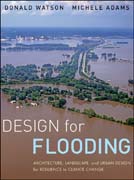
Design for flooding: architecture, landscape, and urban design for resilience to climate change
Watson, Donald
Adams, Michele
INDICE: Preface and Acknowledgments. Foreword (Carol Franklin, RLA, FASLA) Foreword (Daniel E. Williams, FAIA). Introduction. PART I: NATURE OF WATER. Chapter 1: Weather. 1.1 Sun and Earth. 1.2 The Atmosphere. 1.3 Weather. Chapter 2: Land and Water. 2.1 Water and Carbon Cycles. 2.2 Biodiversity and the Landscape. 2.3 Follow the Water: The Opportunity for Watershed Planning. Chapter 3:Flooding. 3.1 Flooding from Increased Precipitation. 3.2 Flooding from SevereStorms. 3.3 Economic and Social Costs of Water-Related Natural Disasters. PART II: DESIGN WITH WATER. Chapter 4: The Natural Landscape. 4.1 Understanding the Natural Water Balance. 4.2 When the Water Balance Is Altered. 4.3 Soils andVegetation. 4.4 Subsurface Water Movement. 4.5 Stream Systems, Wetlands, Riparian Zones, and Floodplains. Chapter 5: The Altered Landscape. 5.1 When the Landscape Is Altered. 5.2 Altered Stream Systems and Increased Flood Damage. 5.3Why Detention Does Not Solve Flooding. 5.4 Summary: The Natural Landscape as a Model for Resilient Design. Chapter 6: Design for Inland Flooding. 6.1 Resilient Design for Inland Flooding. 6.2 Tools for Watershed Protection. 6.3 Communities and Buildings in Floodplains. PART III: FLOOD-RESISTANT DESIGN. Chapter7: Flood Design Analysis. 7.1 Definition of Terms. 7.2 Flood Elevation: Base Flood and Design Flood. Chapter 8: The Coast. 8.1 Coastal Processes. 8.2 Shoreline Protection. 8.3 Flood Barriers and Floodgates. 8.4 Summary of Coastal Protection Measures. Chapter 9: Flood Design Practices for Buildings. 9.1 Overview of Flood Design. 9.2 Flood Design at the Building Scale. PART IV: DESIGN FORRESILIENCE. Chapter 10: Flood-Resistant Design for Sites and Communities. 10.1 Coastal Communities. 10.2 Comprehensive Planning for Resilient Communities. 10.3 Local Actions to Build Community Resilience. Chapter 11: Sea Level Rise. 11.1 Sea Level Rise: The Issues. 11.2 Sea Level Rise: Design Responses. Chapter 12: Design for Resilience. 12.1 The Wave of the Future. 12.2 Models for National and International Action. 12.3 Design Resolution. Epilogue. Glossary. Index.
- ISBN: 978-0-470-47564-5
- Editorial: John Wiley & Sons
- Encuadernacion: Cartoné
- Páginas: 336
- Fecha Publicación: 28/12/2010
- Nº Volúmenes: 1
- Idioma: Inglés
